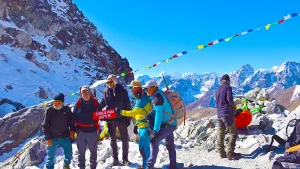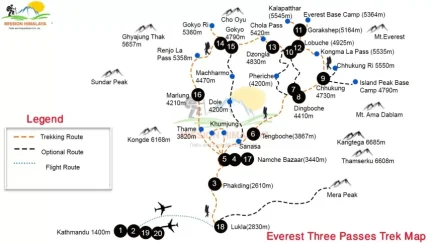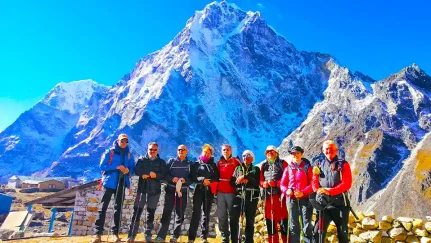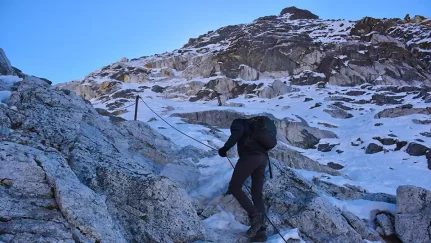Preventing Altitude Sickness on the Everest Three Passes Trek
Trekking in the high mountains of Nepal is an amazing experience, but it comes with challenges. One of the main challenges on the Everest Three Passes Trek is Everest Three Passes Trek altitude sickness. This happens because your body needs time to adjust to the lower oxygen levels at high altitudes. Knowing how to prevent it can make your trek safer and more enjoyable.
Recognizing AMS Symptoms
Acute Mountain Sickness, or AMS, is a common type of altitude sickness on Three Passes. Symptoms can appear even at moderate altitudes. Early signs include headache, dizziness, nausea, shortness of breath, and difficulty sleeping. It is important to recognize these symptoms early. If you feel very tired or weak, it is best to rest and avoid climbing higher until the symptoms reduce. Ignoring AMS can lead to more serious conditions like High Altitude Pulmonary Edema (HAPE) or High Altitude Cerebral Edema (HACE).
Importance of Proper Acclimatization Days
One of the most effective ways to prevent Everest Three Passes Trek altitude sickness is by taking proper acclimatization days. These days allow your body to adjust slowly to higher altitudes. Trekking too fast is one of the main reasons for altitude sickness on Three Passes. Most guides recommend following a schedule that includes rest days at strategic points. During these days, you can do short walks around the area, which helps your body get used to less oxygen without overexertion.
Hydration, Diet, and Pacing Strategies
Staying hydrated is very important at high altitudes. Drinking enough water helps prevent dehydration, which can make altitude sickness worse. Warm drinks like tea or soup can also help your body stay comfortable. Eating small, frequent meals is better than heavy food. Carbohydrates are especially useful because they provide energy without stressing the stomach.
Pacing yourself is another key strategy. Walking slowly and steadily reduces the strain on your body and lowers the risk of Everest Three Passes Trek altitude sickness. Listen to your body, and take breaks whenever needed. Avoid alcohol and smoking, as these can make altitude sickness worse.
Practical Tips for a Safe Trek
- Playing Cards in High Altitude Hotel in everest
Always inform your trekking guide if you notice symptoms of AMS. Guides are trained to manage altitude sickness and know the best steps to take. Using a pulse oximeter can help track oxygen levels, which is useful for monitoring your health. Remember, Everest Three Passes insurance is also important. Make sure your insurance covers high-altitude trekking, medical evacuation, and treatment for altitude sickness. This gives you peace of mind in case of emergencies.
By following these tips, you can reduce the risk of Everest Three Passes Trek altitude sickness and enjoy the beauty of the mountains safely. Proper preparation, attention to your body, and respecting acclimatization days are essential for a successful trek. When you trek carefully and follow these strategies, your experience of crossing the three high passes will be memorable and safe.
Essential Health and Safety Precautions During the Everest Three Passes Trek
The Everest Three Passes Trek is one of the most exciting treks in Nepal, but it also comes with challenges. Proper preparation and safety measures are very important. One of the main concerns is Everest Three Passes Trek altitude sickness, but there are also other health and safety precautions you should know before starting the trek.
Personal Health Preparation Before Trekking
Before you begin the trek, it is important to check your health. A medical check-up can help identify any issues that might make high-altitude trekking risky. Physical fitness is also essential because the trek involves walking long hours in steep and rugged terrain. Training with long walks, stair climbing, or light hiking at lower altitudes can help prepare your body. Proper personal health preparation also includes having the right clothing and gear, which will keep you warm and protected from the cold and wind at higher altitudes. These steps reduce the chance of altitude sickness on Three Passes and other health problems.
- Everest Three passes Trek Altitude Guide
Staying Safe in Extreme Weather and Rugged Terrain
The weather in the Everest region can change quickly. Snow, rain, or strong winds can make the trail slippery and dangerous. Always check the weather forecast and follow your guide’s advice. Walking slowly on steep or rocky paths helps prevent injuries. Trekking poles and sturdy shoes provide extra support and reduce the risk of falls. Dressing in layers allows you to adjust to changing temperatures, which is very important to prevent cold-related illnesses. Proper planning and awareness of your surroundings are key to staying safe during the trek.
First Aid Kits and Common Health Risks
Carrying a well-stocked first aid kit is essential for any trek. It should include medicines for common issues such as headaches, stomach problems, minor cuts, and blisters. High-altitude trekking also means you need medicines for Everest Three Passes Trek altitude sickness. Knowing how to use your first aid kit and when to seek help can make a big difference. Other common health risks include dehydration, sunburn, and fatigue. Drinking enough water, eating nutritious meals, and taking rest breaks are important to avoid these problems.
Additional Safety Measures
Acclimatization days are very important for preventing serious health issues. These rest days allow your body to adjust to higher altitudes and reduce the risk of Everest Three Passes Trek altitude sickness. Listening to your body, not rushing, and communicating any health concerns to your guide are essential safety steps. In case of emergencies, having Everest Three Passes insurance that covers high-altitude trekking and medical evacuation provides peace of mind.
By preparing your body, following safety measures, and being aware of common health risks, you can reduce the chance of Everest Three Passes Trek altitude sickness and enjoy the trek safely. Taking the right precautions, using your first aid kit, and respecting acclimatization days will help make your journey across the high passes a successful and memorable experience.
Travel Insurance and Emergency Planning for High-Altitude Treks
Trekking in the Everest region is a thrilling adventure, but it comes with risks, especially at high altitudes. One of the main concerns is Everest Three Passes Trek altitude sickness, which can affect anyone, even experienced trekkers. Having proper travel insurance and a clear emergency plan is very important to stay safe during the trek.
Choosing the Right Insurance for Trekking in Nepal
Before starting the trek, it is essential to choose the right insurance. Not all travel insurance covers high-altitude trekking, so make sure your policy specifically includes trekking above 5,000 meters. The best policy should cover medical emergencies, helicopter evacuations, and treatment for altitude sickness on Three Passes. It is also helpful if the insurance includes coverage for trip cancellations or lost gear. Checking the policy details carefully ensures you are fully protected in case something unexpected happens.
You may be interest this Trip!!!!
Coverage for Altitude Sickness and Evacuation
High-altitude trekking can lead to serious health issues like Everest Three Passes Trek altitude sickness. Insurance should cover medical treatment for this condition, including oxygen therapy if needed. In emergencies, evacuation by helicopter may be necessary, and the cost can be very high without insurance. Having Everest Three Passes insurance that includes evacuation gives trekkers peace of mind. This coverage allows you to focus on enjoying the trek while knowing help is available if needed.
Steps to Take in Case of Emergencies
Even with precautions, emergencies can happen. Knowing what to do can save lives. If you or someone in your group develops symptoms of severe Everest Three Passes Trek altitude sickness, stop ascending immediately and inform your guide. Descending to a lower altitude is the most effective way to treat serious symptoms. Always carry a fully charged phone, GPS, or satellite device to contact emergency services. First aid knowledge and carrying essential medicines also help manage minor health problems before professional help arrives.
Acclimatization days play a vital role in preventing emergencies. These days allow your body to adjust to higher altitudes and reduce the risk of serious Everest Three Passes Trek altitude sickness. Following a planned schedule with rest days, drinking enough water, and monitoring your health are simple steps that can prevent dangerous situations.
Having Everest Three Passes insurance is not just a requirement but a safety net. It ensures that if an unexpected health issue or accident occurs, you will have access to medical care and safe evacuation. This makes your trek safer and more enjoyable. By combining proper insurance, emergency planning, and respecting acclimatization days, you can focus on the stunning scenery and the experience of crossing the three high passes with confidence.
Proper planning, careful preparation, and the right insurance are essential for high-altitude trekking. With these steps, you can prevent risks, manage emergencies, and reduce the chance of Everest Three Passes Trek altitude sickness, making your journey across the Himalayas a safe and memorable adventure.
Conclusion
The Everest Three Passes Trek is one of the most exciting adventures in Nepal, but it requires careful planning and attention to health and safety. One of the biggest challenges is Everest Three Passes Trek altitude sickness, which can affect anyone at high altitudes. Knowing how to recognize symptoms early, following proper acclimatization days, and pacing yourself are very important to prevent serious health problems. Staying hydrated, eating well, and listening to your body help reduce the risk of altitude sickness on Three Passes and make the trek more enjoyable.
Preparing your body before the trek is also very important. Physical fitness, proper clothing, and carrying a well-stocked first aid kit help keep you safe in extreme weather and rugged terrain. Using trekking poles, walking carefully on rocky paths, and resting when needed are simple ways to prevent injuries. Your guide can also help monitor your health and give advice to stay safe during the trek.
Travel insurance is another key part of safety. Choosing the right Everest Three Passes insurance ensures coverage for medical emergencies, altitude sickness, and evacuation if needed. It gives you peace of mind so you can focus on enjoying the mountains. Emergency planning, knowing what steps to take, and following your guide’s instructions are all part of staying safe at high altitudes.
By taking these precautions, you can reduce the risk of Everest Three Passes Trek altitude sickness and other health problems. Respecting acclimatization days, monitoring your health, and using insurance wisely make the trek safer and more enjoyable. With careful preparation and attention to safety, you can fully enjoy the amazing views, unique culture, and adventure of crossing the three high passes. The trek becomes not just a journey through the mountains, but a safe, memorable, and life-changing experience.
Planning, preparation, and awareness are the keys to a successful trek while minimizing Everest Three Passes Trek altitude sickness.














